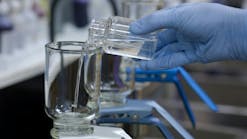By Patrick Crow, Washington Correspondent
The Environmental Protection Agency has issued guidance recommending how public water systems might enhance monitoring and sampling programs specifically for hexavalent chromium. The recommendations are in response to emerging scientific evidence that chromium-6 could pose health concerns if consumed over long periods of time.
The Environmental Working Group (EWG) lit a political firestorm in December when it reported that the toxic metal hexavalent chromium was present in the tap water of 31 of 35 U.S. cities tested.
EWG said samples from 25 cities contained the cancer-causing metal at concentrations above the 0.06 parts per billion maximum proposed by California regulators. The Environmental Protection Agency (EPA) has concluded that hexavalent chromium (also known as chromium-6) is a likely carcinogen.
EWG said, "At least 74 million Americans in 42 states drink chromium-polluted tap water, much of it likely in the cancer-causing hexavalent form. Given the scope of exposure and the magnitude of the potential risk, EWG believes the EPA should move expeditiously to establish a legal limit for chromium-6 and require public water suppliers to test for it."
The American Water Works Association (AWWA) noted that water utilities monitor for total chromium, of which hexavalent chromium is a sub-category. "There is nearly universal compliance with the existing standard, which is good news for tap water consumers," it said.
AWWA added, "While EWG's report may raise concerns, it's important to remember that detecting a substance in water does not always imply a health risk. The key question to answer is whether the substance presents health concerns at the level it is detected."
The enhanced monitoring guidance provides recommendations on where drinking water utilities should collect samples and how often they should be collected, along with analytical methods for laboratory testing. Systems that perform the enhanced monitoring will be able to better inform their consumers about any presence of chromium-6 in their drinking water, evaluate the degree to which other forms of chromium are transformed into chromium-6, and assess the degree to which existing treatment affects the levels of chromium-6 in drinking water, EPA said.
EPA currently has a drinking water standard for total chromium, which includes chromium-6, and requires water systems to test for it. Testing is not required to distinguish what percentage of the total chromium is chromium-6 versus other forms such as chromium-3.
EPA's latest data show that no public water systems are in violation of the standard. However, the science behind chromium-6 is evolving. The agency regularly re-evaluates drinking water standards and, based on new science on chromium-6, has already begun a review of its health effects. In September 2010, the agency released a draft of the scientific review for public comment. When the human health assessment is finalized in 2011, EPA will determine if a new standard needs to be set.
More information on the new guidance to drinking water systems: http://water.epa.gov/drink/info/chromium/guidance.cfm
Lead Legislation
President Barack Obama has signed a bill reducing the lead content of drinking water pipes, pipe fittings and plumbing fixtures.
The House of Representatives had passed a bill last July, sponsored by Rep. Anna Eshoo (D-Calif.). The Senate passed a similar bill in December, sponsored by Sens. Barbara Boxer (D-Calif.) and James Inhofe (R-Okla.).
Previously, federal law allowed plumbing fixtures that carry drinking water to contain up to 8% lead. The new law states that the wetted surface of such plumbing cannot contain more than a weighted average of 0.25% lead.
"The AWWA will support implementation of the bill signed by President Obama and pledges to work with its membership to help reduce the amount of lead in water supplies," said executive director David LaFrance.
He said, "Minimizing potential sources of lead helps assure that high quality drinking water delivered from treatment plants remains safe after it reaches our homes, schools and businesses. Controlling lead exposure in tap water requires a sustained commitment from manufacturers who create fixtures, water providers who optimize corrosion control, and consumers, who can take simple steps to reduce exposure at home. AWWA will continue to provide guidance in each of these areas as part of our longstanding commitment to protect public health."
The Association of Metropolitan Water Agencies, the Plumbing Manufacturers Institute, and other groups also supported the bill.
Boxer said, "Lead -- a toxic heavy metal -- does not belong in our drinking water. This is a major step forward in the effort to eliminate lead in our drinking water."
Inhofe said, "It isn't often that Senator Boxer and I agree on legislation. Yet in this case, we did. Here is an opportunity to pass a bill that will help further decrease the amount of lead in water without imposing a burden on America's manufacturers."
Bottled Water Survey
EWG said its survey of 173 bottled waters sold in the U.S. found that only three -- and only one of the top 10 domestic brands -- gave customers information about the water's source, the method of purification and chemical pollutants in the water.
The environmental group said Nestlé's Pure Life Purified Water discloses its water source and treatment method on the label and publishes a phone number so that consumers can request a water quality test report. But the nine other top domestic brands -- Coca-Cola's Dasani, Pepsi's Aquafina, Crystal Geyser, and six other Nestlé's brands -- don't answer key questions.
EWG's survey found 18% of bottled waters fail to list the source and 32% disclose nothing about the treatment or purity of the water.
Jane Houlihan, EWG's senior vice president for research, said, "Bottled water companies try hard to hide any information consumers may find troubling. They don't tell where the water comes from and what pollutants they may have found. Their ads depict mountain streams and natural springs. Yet nearly half the time, according to the industry's own statistics, they're bottling tap water."
EWG urged consumers to drink filtered tap water rather than bottled water. "It costs far less than bottled water and doesn't come wrapped in plastic waste to clog landfills, clutter streams and rivers, and build up in the ocean," it said.
Meanwhile, the International Bottled Water Association (IBWA) reported the national recycling rate for common polyethylene terephthalate (PET) plastic bottled water containers was 31% in 2009, up from 30.9% the previous year.
IBWA said, "The doubling of the recycling rates for bottled water containers over the past five years is encouraging but also a reminder that more needs to be done to expand recycling efforts and collection methods across the country."
In other Washington news:
-- EPA and the Justice Department said DeKalb County, Ga., has agreed to make major improvements to its sanitary sewer systems to eliminate overflows of untreated sewage. It will pay a civil penalty of $453,000 and implement a $600,000 remedial project.
-- EPA has published a final regulation on carbon dioxide geosequestration wells as part of its Underground Injection Control program. The rule was effective Jan. 10.
-- The Water Environment Federation has named Jeff Eger as its executive director. Eger formerly was executive director of Sanitation District 1 in Fort Wright, Ky. He replaced William Bertera, who had held the post since 2001.
-- United Water has refuted Justice Department criminal charges concerning the company's operation of the Gary, Ind., Sanitary District facilities between 1998 and 2010. The company said, "The government's claim is, at best, a disagreement about operating and monitoring methods, with no allegation of environmental harm."
-- EPA and the Justice Department reached a settlement with the Northeast Ohio Regional Sewer District to cut the flow of untreated sewage into Cleveland area waterways and Lake Erie. The district will spend $3 billion for improvements and will pay a $1.2 million fine.
-- President Obama has signed a bill to require federal departments to pay local fees for the treatment and management of stormwater runoff. Some federal auditors refused to allow the fees, which they said were unconstitutional taxes on the federal government.
WW
More WaterWorld Current Issue Articles
More WaterWorld Archives Issue Articles


